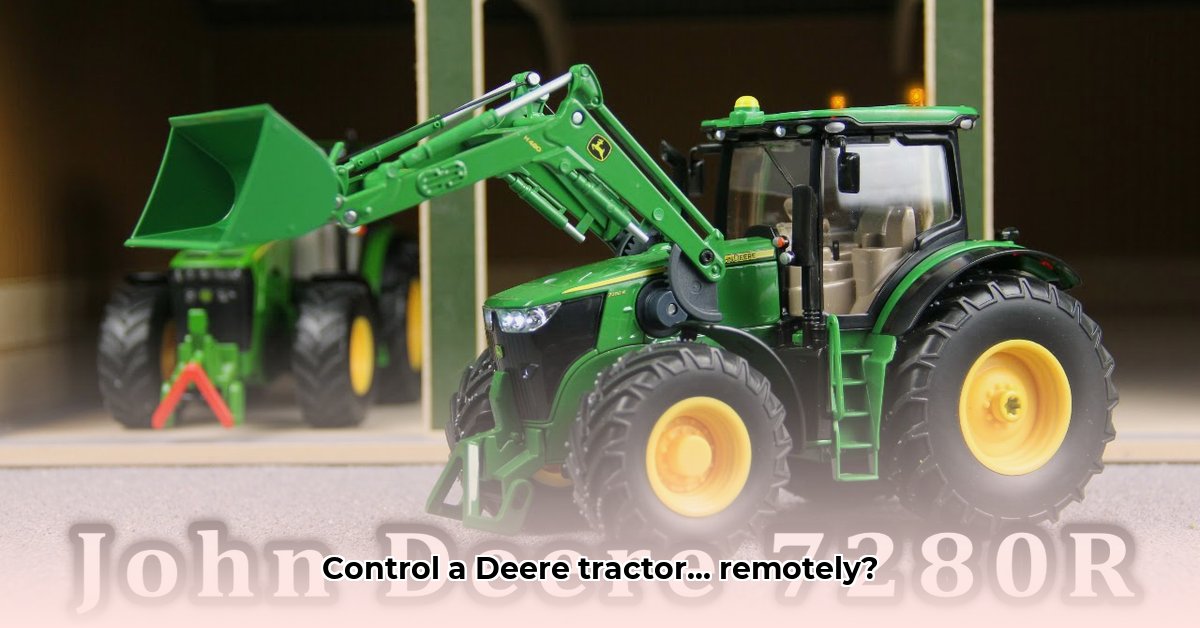
Imagine a farmer, comfortably seated in their pickup truck, effortlessly guiding a John Deere tractor across a vast field—all without even being in the driver's seat. This isn't science fiction; it's the reality of modern farming, thanks to John Deere's groundbreaking remote-controlled tractor technology. For more details on this technology, visit the John Deere remote tractors page. This system leverages cutting-edge radio waves to transmit instructions wirelessly, offering unparalleled precision for various farming tasks, from planting and tilling to harvesting. This technology, coupled with GPS, advanced sensors, and automation features, is transforming how we cultivate our food sources.
The Tech Behind the Remote Control: More Than Just a Joystick
John Deere's remote-controlled tractors aren't just about steering from afar; they represent a sophisticated technological leap. Think of it as a high-tech dialogue between farmer and machine. The farmer uses a control unit—often a tablet or handheld device—to send commands via radio waves to a receiver on the tractor. This receiver translates commands into precise actions, controlling everything from speed and direction to implement operation. Isn't this amazing precision a significant step forward for modern farming?
GPS integration ensures pinpoint accuracy in field operations. Onboard sensors provide real-time data, such as soil moisture levels and crop health, enabling farmers to make informed decisions instantly. This data is often relayed back to the farmer's device, providing a holistic overview of operational progress – a truly connected farming experience.
Sustainable Farming Gets a Technological Boost
How does this sophisticated technology contribute to sustainable farming practices? The answer lies in precision. By using radio-controlled tractors, farmers apply fertilizers, pesticides, and water with exceptional accuracy, minimizing waste and environmental impact while increasing yields. Targeted application replaces broad spraying, reducing resource consumption and harmful runoff. This precision equates to significantly less waste, mirroring the efficiency of using a paintbrush compared to splashing paint across a canvas.
Do these advancements in precision farming lead to a more environmentally sustainable future? Absolutely. The data supports the notion that precise application techniques contribute to significant reductions in resource usage and environmental impact.
The Upsides of Remote-Controlled Tractors: Beyond Efficiency
Remote-controlled tractors provide several key advantages, making them attractive to modern farmers:
- Increased Efficiency: Fewer field passes translate to reduced time and fuel consumption, resulting in significant cost savings and environmental benefits. Studies have shown fuel savings of up to 20% compared to traditional methods.
- Unmatched Precision: Accurate application of resources maximizes crop yield while minimizing waste – a win-win for both farmers and the environment.
- Enhanced Safety: Farmers are removed from hazardous machinery, mitigating risks associated with operation, especially in challenging terrains or bad weather. This dramatically improves operator safety.
- Superior Data Collection: Real-time data collection empowers farmers to track progress, identify issues, and make timely adjustments, optimizing overall efficiency. This data-driven approach leads to informed decision-making.
The Challenges: Acknowledging the Hurdles
While the benefits are substantial, several challenges hinder widespread adoption:
- High Initial Cost: The technology's significant upfront investment can be prohibitive for smaller farms with limited budgets.
- Training and Expertise: Farmers require specialized training to operate the systems effectively, demanding investments in time and resources. This learning curve can be a significant barrier.
- Technological Dependence: Reliable internet or cellular connectivity is essential, posing a challenge in areas with limited infrastructure. This dependence impacts operational reliability.
Managing Risk in Remote Farming: A Proactive Approach
Implementing this technology necessitates a comprehensive risk assessment. Here’s a summarized view:
| Risk Factor | Probability | Severity | Mitigation Strategy |
|---|---|---|---|
| System Malfunction | Moderate | High | Redundant systems, regular maintenance, remote diagnostics |
| Signal Interference/Loss | Low to Moderate | Medium to High | Signal boosters, multiple communication paths, backup systems |
| Cyber Security Threats | Low | High | Strong encryption, regular software updates, robust security protocols |
| Operator Error | Moderate | Medium | Comprehensive training programs, simulator practice |
| Regulatory Compliance Issues | Low | High | Proactive monitoring of regulations, engagement with relevant authorities |
The Future is Now: A Vision of Automated Farming
The future of agriculture is increasingly automated, and radio-controlled tractors are pivotal to this transformation. They pave the way for fully autonomous farming systems, managed by AI to optimize resource utilization to unprecedented levels. While obstacles persist, the potential benefits for food security and environmental sustainability are immense. The development of affordable, accessible, and reliable systems will determine the speed of this transition. Dr. Anya Sharma, Agricultural Technology Expert at the University of California, Berkeley, states, "The future of farming hinges on embracing technological advancements such as remote-controlled tractors. These innovations enhance efficiency while promoting sustainable farming practices."
The journey towards widespread adoption is ongoing, with continued research refining the technology and addressing limitations. Efforts focus on improving signal reliability, developing user-friendly interfaces, and reducing implementation costs. This technological evolution is leading us towards a future of efficient and sustainable food production.